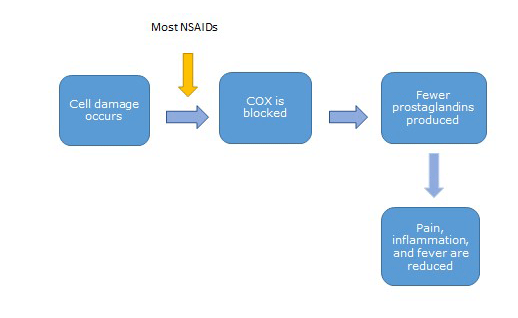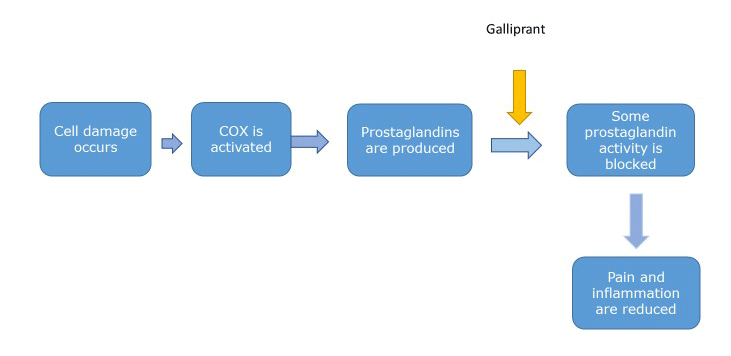Galliprant—A Nonsteroidal Anti-Inflammatory Drug (NSAID) for Dogs with Osteoarthritis
Osteoarthritis (OA) is a condition where cartilage - the protective material that cushions a joint - breaks down over time, causing the bones to rub against each other. This rubbing can permanently damage the joint and cause pain, inflammation, and lameness. Older and overweight dogs are at higher risk of developing OA.
Available since March 2016, Galliprant (grapiprant tablets) is the newest active ingredient approved to control the pain and inflammation associated with OA in dogs. Galliprant is part of a group of drugs called nonsteroidal anti-inflammatory drugs (NSAIDs). Several other NSAIDs are approved to control pain and inflammation in dogs with OA (see Table 1), but Galliprant works at a slightly different point on the inflammatory pathway.
| Active Ingredient | Brand Names |
|---|---|
| Carprofen | Marketed under multiple trade names |
| Deracoxib | Deramaxx, Doxidyl* |
| Firocoxib | Previcox |
| Grapiprant | Galliprant |
| Meloxicam | Marketed under multiple trade names |
*Indicates an FDA-approved generic copy.
Inflammatory Pathway
Inflammation is the body’s response to irritation or injury. After a cell is damaged, an enzyme called cyclooxygenase (COX) is activated. (An enzyme is a protein made by the body that speeds up a chemical reaction.) COX then stimulates the cell to produce substances called prostaglandins, which contribute to signs of inflammation such as pain, redness, warmth, swelling, and fever.
The inflammatory pathway works like this:
Prostaglandins are present throughout the body and have several important functions besides contributing to the inflammatory pathway. Prostaglandins also protect the lining of the stomach and intestines; help maintain blood flow to the kidneys; and support platelet function (platelets are found in the blood of all mammals and help with blood clotting).
Galliprant Blocks Activity of a Specific Prostaglandin
All NSAIDs affect prostaglandins, either by blocking COX so fewer prostaglandins are produced or by blocking some activity of certain prostaglandins. The result is less pain and inflammation.
Most NSAIDs listed in Table 1 work by blocking COX:
Galliprant is an NSAID that does not block COX. It works lower down the inflammatory pathway by blocking some activity of a specific prostaglandin:
Side Effects and Client Information Sheet
Because all NSAIDs interfere with the other positive functions of prostaglandins, they can cause side effects, some of which are serious. Galliprant is no exception. The most common side effects seen in dogs receiving Galliprant are:
- Vomiting;
- Diarrhea;
- Decreased appetite;
- Decreased activity level;
- Soft stool with mucus; and
- Watery or bloody stool.
Giving Galliprant and another NSAID for dogs (for example, carprofen or meloxicam) at the same time or giving Galliprant with a steroid such as prednisone increases the risk of side effects and should be avoided. Giving Galliprant and an NSAID for people (for example, aspirin or ibuprofen) at the same time also increases the risk of side effects and should be avoided. In addition, NSAIDs for people are not approved for animals and have not been shown to be safe and effective in dogs.
Owners should contact their veterinarian if their dog experiences side effects from Galliprant. FDA’s Center for Veterinary Medicine also encourages owners to work with their veterinarian to report the problem.
Every oral NSAID approved for dogs, including Galliprant, has an accompanying Client Information Sheet for veterinarians to give owners the first time the prescription is filled and each time it's refilled. The Client Information Sheet for Galliprant is written specifically for dog owners and serves as an easy at-home reference. The sheet summarizes important information about the drug in a user-friendly format.
Long-Term Use
Because OA is a long-term (chronic) condition that doesn’t go away, a dog may be on Galliprant for an extended period of time. The lowest dose that provides adequate pain control should be used. Owners should always consult with their veterinarian before adjusting the dose, especially before increasing it.
Owners should ask their veterinarian about performing baseline blood tests to check kidney and liver function before starting their dog on Galliprant for long-term use for OA. Owners should also periodically discuss their dog’s response to Galliprant with their veterinarian, including what type of monitoring should be done (such as rechecking blood tests) and how often.
See Animal Drugs @ FDA for more information about Galliprant.
Resources for You
- Get the Facts about Pain Relievers for Pets
- Veterinary Non-Steroidal Anti-Inflammatory Drugs (NSAIDs)
- Treating Pain in Your Dog – Keeping Your Best Friend Active, Safe, And Pain Free
- NSAID Labels – Currently Approved Labels for Companion Animal Non-Steroidal Anti-Inflammatory Drugs (NSAIDs)
- Medications for your Pet…Questions for Your Vet
- Pain Medicines for Pets: Know the Risks
For More Information
Contact FDA’s Center for Veterinary Medicine at either AskCVM@fda.hhs.gov or 240-402-7002.



